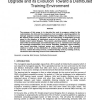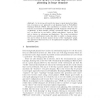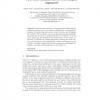1256 search results - page 86 / 252 » Learning to Reason |
LEGE
2003
13 years 11 months ago
2003
The purpose of this paper is to describe the work in progress related to the customisation, the trial and the evaluation of an innovative e-learning platform for manager upgrade i...
PUK
2000
13 years 11 months ago
2000
Abstract. In the stream of research that aims to speed up practical planners, we propose a new approach to task planning based on Probabilistic Roadmap Methods (PRM). Our contribut...
IVC
2008
13 years 10 months ago
2008
Complex scenes such as underground stations and malls are composed of static occlusion structures such as walls, entrances, columns, turnstiles and barriers. Unless this occlusion...
JAIR
2006
13 years 10 months ago
2006
Resolution is the rule of inference at the basis of most procedures for automated reasoning. In these procedures, the input formula is first translated into an equisatisfiable for...
ILP
2004
Springer
14 years 3 months ago
2004
Springer
Random forest induction is a bagging method that randomly samples the feature set at each node in a decision tree. In propositional learning, the method has been shown to work well...



